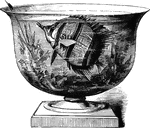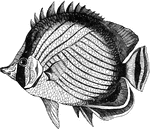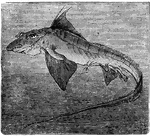79 illustrations of fish including: carp, catfish, charr, chub, cigarfish, coalfish, cobia, cod, corsair, cottus, cowfish, crappie, croaker, cunner, dab, dace, darter, dealfish, dogfish, dragonet, and drum

Copperband Butterflyfish
"It feeds upon insects, and is remarkable for its method of procuring them. When it observes a fly,…

Carp
"They are distinguished by a small mouth and powerful teeth, though not set in the jaws. The body is…

Carp
"Carp is a fresh-water fish. It is a native of Asia, but has been extensively introduced into the United…

Carp
"External characters of a Teleostean--a carp (Cyprinus carpio). R., Dorsal unpaired fin; S., homocercal…

Carp
Carp is a common name for various freshwater fish of the family Cyprinidae, a very large group of fish…

Carp
Carp is a common name for various freshwater fish of the family Cyprinidae, a very large group of fish…

Common Carp
"It is ten to forty inches long, and sometimes attains the weight of a hundred pounds; the general color…

Common Carp
"Carp (Cyprinus carpio). a.-- fore fin; b.-- hind fin; c.-- anal fin; d.-- large barbule. Carp, a genus…

Gold carp
"The Gold Carp, C. auratus, often called the Gold-fish and silver-fish, as it assumes both…

Catfish
Catfish are found in lakes and streams of North America, usually at muddy bottoms. Catfish have a large…
Electric Catfish
Electric catfish is the common name for the catfish (order Siluriformes) family Malapteruridae. This…
Electric Catfish
Electric catfish is the common name for the catfish (order Siluriformes) family Malapteruridae. This…

Gafftopsail Catfish
The Gafftopsail Catfish (Bagre marinus) is a fish in the Ariidae family of ariid catfish. It was also…

Upside-down Catfish
Upside-down catfish, Synodontis nigriventris, is a species of catfish. It's particularly noteworthy…

Wels Catfish
The wels catfish is a scaleless fresh and brackish water catfish recognizable by its broad, flat head…

Wandering Chaetodon
"Twelve inches long, body of a pale yellow color, with numerous oblique, brownish-purple lines. Inhabits…

Northern Charr
"A European species, and inhabits the northern lakes of England and those of Scotland; it is from one…
Chilobranchus
A genus of fishes whose branchial apertures are close together below, and are surrounded by a lip-like…

Chimaera Monstrosa (the Arctic chimaera)
"The king of the herrings is from three to four feet in length, of a general silvery color, spotted…

Chub
"Frequents deep places in the quiet parts of steams, sheltering itself usually under a bush or tree…

Chub
"A fish of the family Cyprinidae, of the same genus with the roach, dace, bleak and minnow. The color…

Bermuda Chub
A fish with skin and scales encroaching on the drsal and anal fins, which are consequently thickened.

River Chub
A cyprinoid fish, the hornyhead or jerker. Widely distributed and abundant in the United States, attaining…

Cichla
A genus of fishes inhabiting the fresh waters of South America, and typical of the family Cichlidæ.
Clingfish
Gobiesox reticulatus is a species of Clingfish, a bottom dwelling fish that live in shallow waters.
Coalfish
"A large species, weighing from ten to thirty pounds. It swims rapidly, and at no great depth." —…

Cobia
A spanish name for a sergeant&mdashfish. Usually has a uniform shape with a wide flattened head, and…

Common Cod
"It is two to four feet long, and weighs from two to seventy spounds; the general color is greenish…

Comber
The Comber (Serranus cabrilla) is a small fish of the Serranidae family of perch-like fishes.

The Common Plaice (Platessa Vulgaris)
"The Common Plaice attains a length of twelve to eighteen inches. On the eye side of the head are some…

Corsair
A fish with smooth cranial ridges, moderate size scales, and pale blotches surrounded by purple shades…

Four-horned Cottus
"Six to eight inches long, feeds on young gobies, which it catches by lying in ambush among stones or…

Crappie
A sunfish. Has a compressed body incurved profile and the relative positions of the dorsal and snal…

Cunner
The blue perch. Up to 12 inches in length and having about 18 dorsal spines, conical teeth in several…

Dab
The teeth are compressed and trunctated, and the lateral line is cimple and arched above the pectoral.

The Dab (Platessa Limanda)
"The Flounders and Plaice inhabit the northern seas of Europe. They have the eyes placed on the right…



















